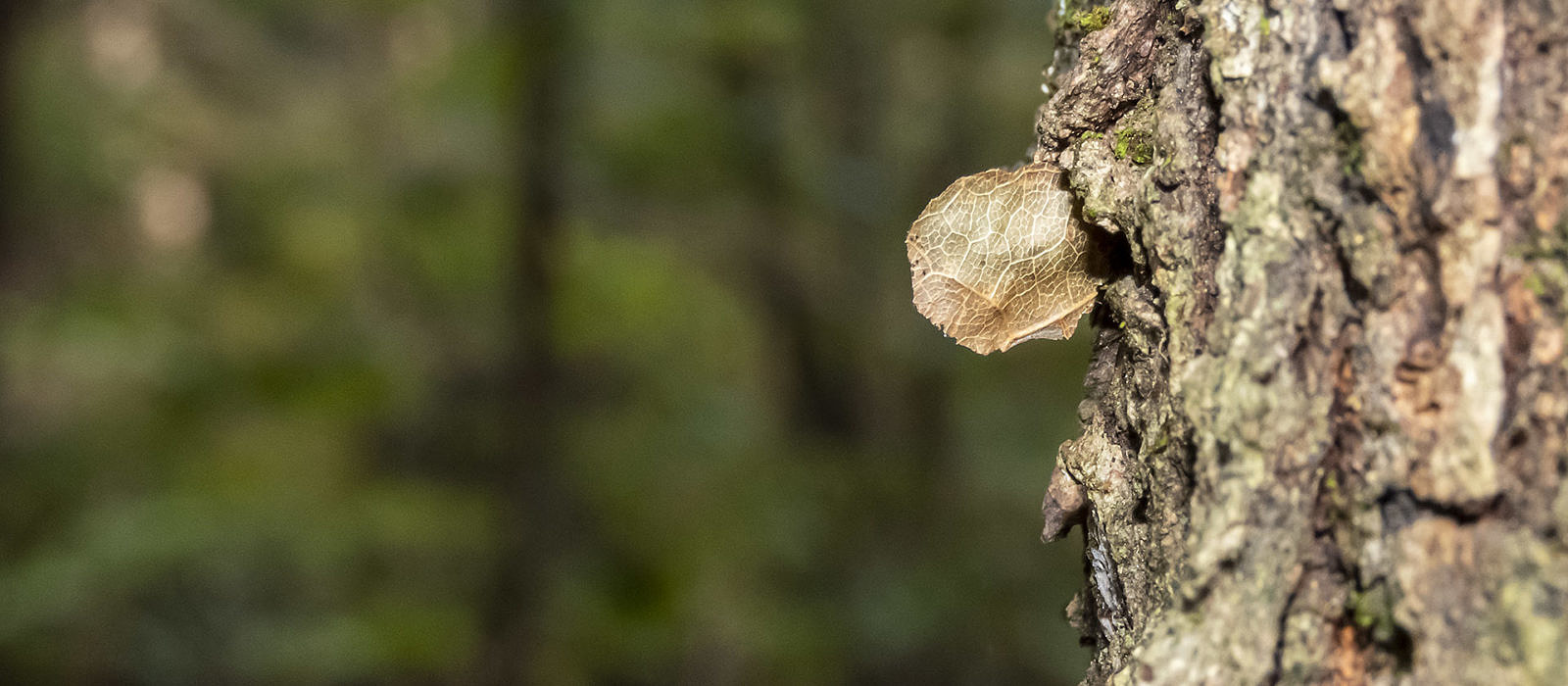
Fall Migration
In the Skies and at Your Feet
The great journey begins. Today here in Vermont, the first big waves of migrating raptors, Broad-winged Hawks, are drifting past mountain summits on their way toward Central America. Vermont to Costa Rica: 3,500 miles.
The Monarch migration is now surging, with huge numbers reported from the U.S. heartland and Northeast this week, including “too many to count” at Vermont’s Mt. Philo today. Mt Philo to Mexico: 2,400 miles.
And even a few ambitious dragonfly species, including the Common Green Darners I chased around on Tuesday, are now heading south for winter. My backyard to Everglades National Park: 1,400 miles.
Yet here in the woods of home, rather than chasing hawks or butterflies, I’m tracking the epic migration of a caterpillar called Maple Leafcutter. Maple sapling to forest floor: 4 feet.
From whales to warblers to wildebeests, animals are now on the move in some of the planet’s most audacious feats of adaptation and survival. Even so, you need not visit the Serengeti or the high seas to witness these mass movements. Instead, visit the woods, recalibrate your horizon, and lower your gaze: the drama of migration unfolds at your feet.
As some of you know, I’ve been obsessed with these little caterpillars for more than two decades, having reported on them as recently as last month. Yet nature is nothing if not an endless opportunity for discovery. Even a prosaic caterpillar continues to inspire and amuse me. Maple Leafcutters (Paraclemensia acerifoliella) are now on the move — from (yeah, you guessed it) maple leaves to the forest floor for winter.
Perhaps you’d prefer to discover more charismatic migrants likes hawks and Monarchs; you can do that at my new feature here on the site called Migration Central. But if you cannot get yourself up a mountain for hawks or out to sea for whales anytime soon, if you’ve never seen tropical leafcutter ants in action, well, here is our own insect transporting bits of leaf through the forest … yet ever so slowly.
I will summarize in more detail, at the end of this essay, the four-month, even four-foot, odyssey of a caterpillar, most of it carried out on a single leaf. But first, I’ll admit that I’ve been harassing Maple Leafcutters into performing some heroic acrobatics.
I’ll admit that I’ve been harassing Maple Leafcutters into performing some heroic acrobatics.
Since May these tiny larvae have been munching on maple, most of the time while shrouded in two or more discs that they cut from their leaf and stitch together like little green “pitas.” Actually, most are now inside their pitas and covered by yet another larger disc. It allows the caterpillar to poke its head out of its pita and feed on the live leaf tissue under cover and without detection. Well, at least until I came along and turned their worlds upside down.
In the video below, I flip a shelter — like turning over a turtle — to expose the smaller pita and the caterpillar inside. I did that a lot this week. In most instances, the caterpillar righted its leafy ship within a few minutes (or I lost patience waiting). This one below takes about a minute.
You can now see all this for yourself in hardwoods here in the Northeastern U.S. I’m finding Maple Leafcutters almost exclusively on Sugar Maples (Acer saccharum), often near forest edges or sunny breaks, although my colleague Shelby Perry recently discovered them rarely on American Beech. (I suspect their occurrence on other maple species may be incidental or accidental.) Many are still on their leaves and feeding waist-high on saplings where you can easily observe them.
But many others have already “migrated” to the forest floor. Rather than walk, they float to earth in their leafy shelters when the autumn winds shake the trees, when the squirrels might disrupt things, or when their host maples leaves themselves fall for the season. Yes, this is a passive migration, to be sure, but animal movement nonetheless.
Once on the ground, the caterpillars have two options. They pupate in their shelters and begin their transformation next spring to a free-flying moth with steely blue wings and an orange head. Or, if they’ve fallen too soon in the season, they’ll sometimes climb back up a tree — like that one in the banner image above — to continue feeding on its maple leaves. My suspicion had been that by mid September they’re mostly done feeding for the year — and therefore have no business climbing back up a maple. But Shelby reports big-time tree climbing in Hubbard Park here in Montpelier on 25 Sep 2018. (This is why naturalists keep field notes.)
The world already spins too fast. Nothing like a caterpillar to slow us down.
In any event, besides flipping them like pancakes, I’ve been on my belly a lot watching bits of maple leaf marching through the forest. Okay, marching isn’t really accurate. These things make snails look like cheetahs. But that’s okay. The world already spins too fast. Nothing like a caterpillar to slow us down.
So take an hour or so and watch a Maple Leafcutter lug around its shelter for a few inches. Let that be your meditation on slowing down in nature, which is good for you.
After all, somewhere on the planet right now an Arctic Tern, the epitome of migration, is flying from its breeding grounds in the high Arctic toward Antarctica — a four-month journey between the poles covering more than 20,000 miles. Meanwhile, over the course of four moths here at home, a tiny forest caterpillar might move no more than four feet. Its singular purpose is metamorphosis — to be released from the bounds of a maple leaf so that it may at long last fly free in our forests on wings of its own — a journey no less remarkable than the far-flung peregrinations of a tern.
The Maple Leafcutter Life Cycle
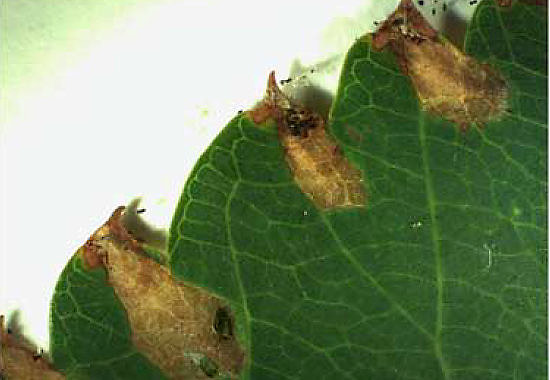
Spring
Adults emerge in spring to mate. Females lay eggs on the underside of Sugar Maple (Black Maple as well toward the Midwest), although they rarely use other species as well. Using her sharp ovipositor, the female creates a series of tiny pockets in the tissue, most often at the leaf margin, into one of which she deposits a single egg (occasionally more).
Within a week or two, usually by June here in Vermont, a caterpillar hatches and makes its egg shell its first meal. After that, it begins to feed on the leaf tissue from within the pocket that its parent excavated during egg-laying. As it feeds, the caterpillar can leave serpentine, linear, trumpet-shaped leaf or blotchy mines (chewed-out sections in the leaf). Image source: Pohl et al. (cited below)
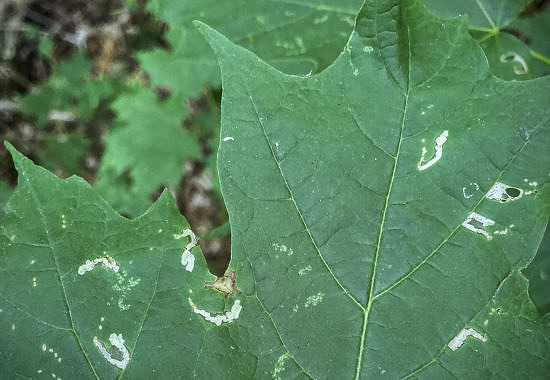
Early Summer
By early summer, at least here in Montpelier, Vermont, in 2020, sugar maple leaves begin to show the first signs of larval feeding. These aren't complete discs, but rather "commas" and other odd squiggly shapes in the leaf tissue. Like 2019, 2020 was a heavy year for Maple Leaf-cutters here in Montpelier. This photo was from 24 June 2020.
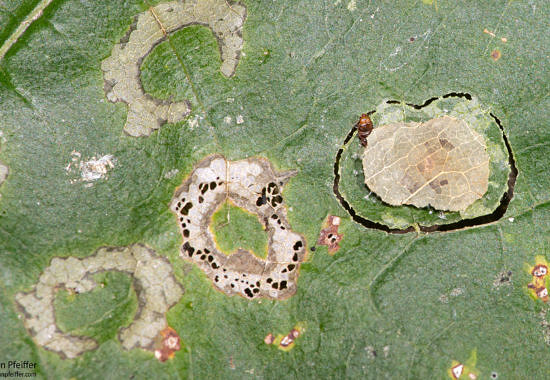
Summer
Next comes the disc-making stage. The caterpillar cuts (by chewing) two oval discs in the maple leaf, one larger than the other, and stitches them together. It carries its disc to a feeding spot on the upper surface of the leaf. From within this shelter, with the larger disc on top serving as overhanging roof, the caterpillar feeds on the leaf tissue just beyond the perimeter of the smaller, lower disc. This creates the skeletonized crescent or oval patches on the leaf surface that you can see in this image, which were made earlier by either this caterpillar or another. You can also see "stitching" on the disc covering the caterpillar.
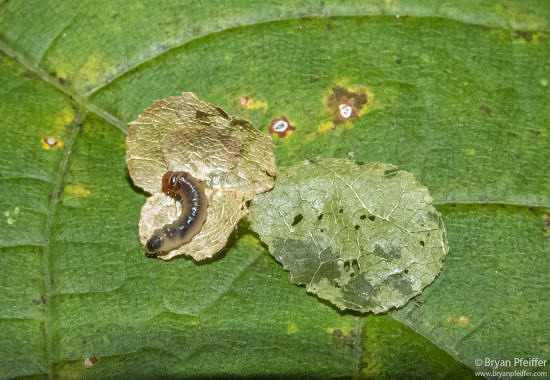
Late Summer
As the caterpillar feeds, it molts and begins to outgrow its shelter. So it keeps adding new discs to its initial shelter, under which it continues to feed. In this image, I've opened up a shelter. We're seeing the caterpillar resting by two pale halves of its shelter (like an open clamshell). But take a look at the upper half and you'll see an even-smaller disc from an earlier shelter. We're also seeing the largest outer cover disc (greener and on the right), which had covered the smaller shelter.
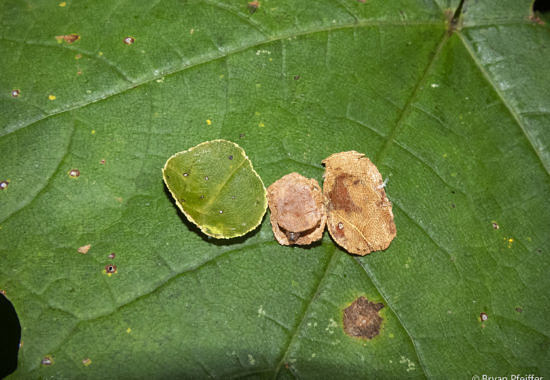
Late Summer-Fall
For this image, I opened the outer layers of a fully-formed shelter to find a smaller shelter within, and the caterpillar inside (partially hidden). The entomological literature points to as many as six leaf case shelters. But it could be that the caterpillar eats earlier shelters or they decay and disintegrate. If I had opened that smaller shelter around the caterpillar, I suspect I might have seen remnants of an earlier shelter inside. Overall, I suspect this shelter, with its thick outer leaf discs, is the final form before the caterpillar drops to earth to pupate and spend the winter.
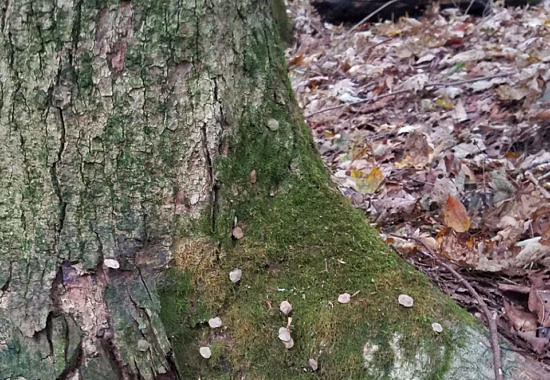
Fall
Here we take "fall migration" literally, as the caterpillars drop to earth from their leaves. It's happening now, as I write in mid September, with caterpillars in their cases still on leaves and others sprinkled about the forest floor at my study site. Not long after they're on the ground, the enterprising stage of this insect, the case-building phase, comes to its rightful conclusion. No more chewing — unless, however, the caterpillar decides to climb up a maple for more feeding, which we're seeing here in a photo from Shelby Perry.
Otherwise, within its fallen case, the caterpillar will weave itself a silken cocoon, and sometime during the next two or three weeks become a pupa. (By the way, despite their shelters, various wasps or other parasites might by now have infected lots of these caterpillars, preventing the life cycle from progressing.)
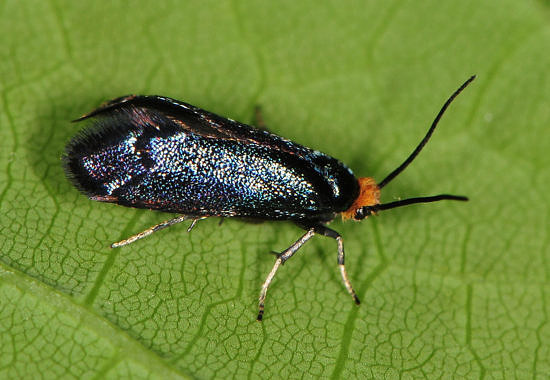
Winter–Spring
The survivors overwinter as the pupa, during which time one of the most striking transformations in all of nature happens: a crawling, chewing, case-building caterpillar transforms into a small day-flying moth — to take flight here in May just as fresh Sugar Maples leaves emerge — and the cycle begins again. Image © Jason Michael Crockwell (via iNaturalist and Creative Commons)
References and Resources
Bionomics of the Maple Leaf Cutter, Paraclemensia acerifoliella (Fitch), (Lepidoptera: Incurvariidae) by D.A. Ross. The Canadian Entomologist, Volume 94, Number 10. October 1962.
Paraclemensia acerifoliella (Lepidoptera: Incurvariidae) in western Canada: A newly discovered host, an expanded range, and biogeographical considerations by Gregory R. Pohl, Christi Jaeger, Vazrick Nazari, Chris Schmidt, Danika Richard, Stan Gosche. The Canadian Entomologist. December 2014.
Maple Leafcutter records from iNaturalist — nice examples of discs and adults.
And special thanks to my leafy, inquisitive colleagues: Nona Estrin, Shelby Perry, Susan Sussman (for reports from Mt. Philo today), and especially Trish Hanson, who first helped me discover these insects (and many others) about 20 years ago.
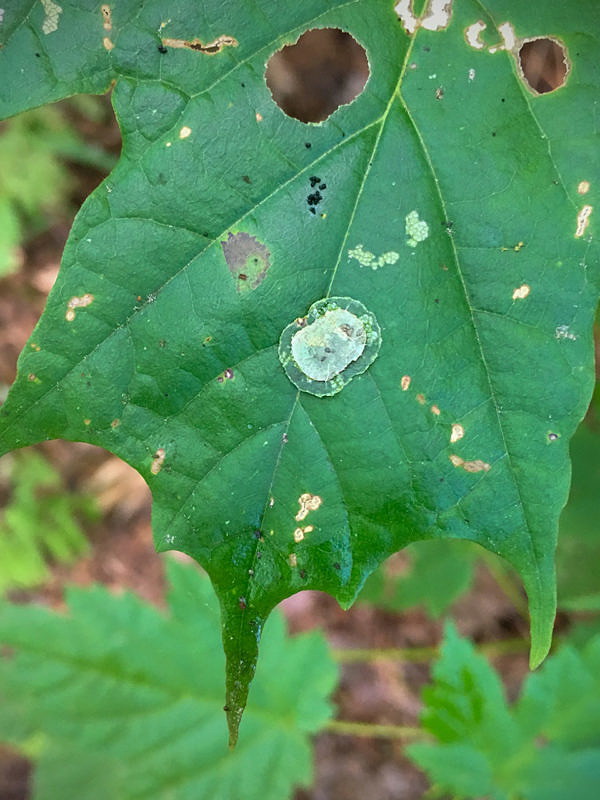

They’re on the maple leaves and on the ground now, Dana!
I love this! As soon as today’s rain lets up, I’m heading out into the woods to see if I can find some of these fascinating creatures!
Hi Joan,
It’s so great to hear from you — and of your observations. The main way they get onto maples is that females lay eggs almost exclusively on maple leaves — mostly Sugar Maple — in spring. (We’ve also seen them, rarely, on American Beech.) I used to think that the larvae, even in their little pitas, crawl around. But I really don’t think they move that much that way. More often, when I find them on a tree trunk, like in that banner photo above, it’s because they fell or blew off a leaf and somehow “landed” haphazardly on the tree trunk. Their migration, I think, is really just dropping or getting blown to earth. But maybe we should all spend more time just sitting by trees and watching — for hours. 🙂 Not a bad way to spend a few hours!
Thanks for that Yellow-rumped Warbler observation. I’ve also seen Black-capped Chickadees pecking open those shelters.
Thank you, Bryan! I ran across them this fall and wondered what they were doing inching — millimetering really — up tree trunks, sometimes up non-maples. I wondered if they go up maples preferentially, able to detect a species by its bark. ?? Seemed (but who will do the science for me?) also that on leaves of other species with damage there were more incomplete circles. A neat note— yellow-rump warblers were feeding on them in flocks in mid-September on the driveway. They would seize a sandwich, knock it once or twice against the ground, then apparently get the caterpillar out to eat.
Yes, here as well in Montpelier. Normally, these late-season leaf-eaters don’t cause a lot of long-term damage. And I suspect these moths go in cycles. But I’ve been wondering the same, Laurie. I’m on the road, but will look into it when I return!
Here in Central Vermont (Orange County) we are experiencing a multi-year infestation that is seeming to become worse each year. All of our maples are affected. How many years do the cycles average? The infestation is spreading over a larger area each year… and our maples have lost a good percentage of their leaves earlier each season, this year starting in mid August.
I love it when folks discover things I’ve written about. Keep me posted, Judy!
Always a pleasure, Maryella!
I’m seeing lots sprinkled on the ground now, Judy!
Or maybe the alien if those leafcutters think they’re being “abducted.”
See if any of those fall warbler discover them as well! Thanks, Martha. (No relation. :-))
I get that despair when the butterflies and dragonflies stop flying for the year. It’s coming — so, too, will my fall funk.
One thing I love about nature: always something new right under our noses! 🙂
Hi Deborah, Normally, this late in the season, I wouldn’t suspect they’d have a big impact on maples. But they do seem to be so thick in certain places, so I suspect that if they’re heavy on the trees year after year that they may indeed have some effect. (I had meant to write a bit about this in my post.)
Let us know is YOU’RE seeing anything through that telescope.
You are like a telescope for our eyes, Bryan! huge thanks!
Yes, so very interesting – thanks, Bryan. But – I am wondering about their impact on maple trees – have not encountered these guys yet, although I’m sure they are in my neighborhood here in south coastal Maine.
Deb D.
The day after I read your blog I started noticing the maple leaf cutter holes- WOW, what an in-the-moment experience-they were everywhere!! I had noticed this before on some maple leaves but thought it was some kind of a virus. Thanks for this great bit of teaching Bryan.
Never knew! Looking elsewhere is what one must do when the birds are not flying…
I almost despaired that there wouldn’t be a photo of the moth.
Something to search for – to discover – when out looking for Fall warblers. T
hanks, Bryan!
You are now known in the Leafcutter world as “the annoying man who flips us over.”
Thanks Bryan. I’m going to be on the lookout now too. So much I miss.
I find you so interesting yet again. Thank you for my science lesson today.
Fascinating stuff! I had no idea about the construction of their cases, etc. Will be watching now for signs of them!